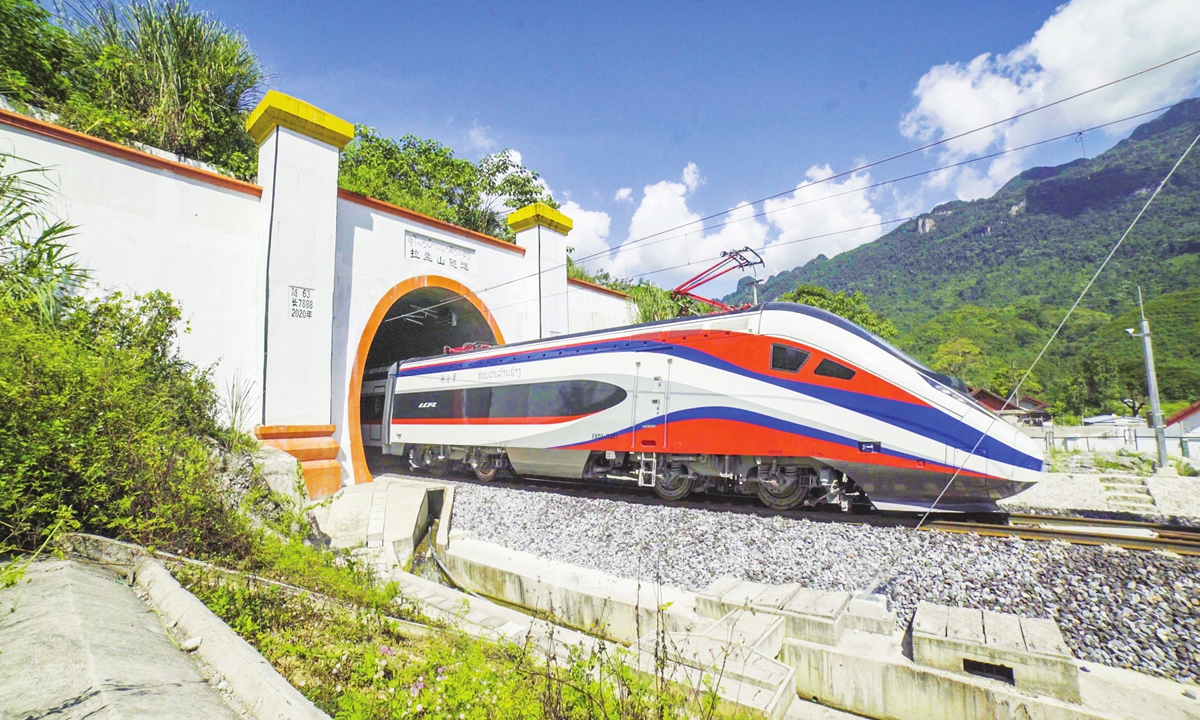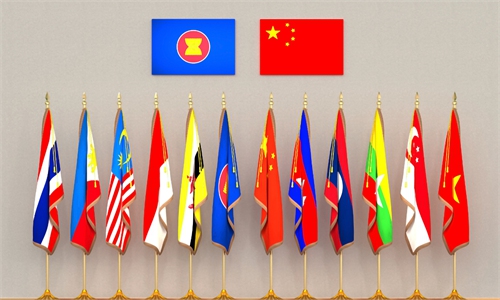
A section of the China-Laos Railway built by PowerChina Photo: Courtesy of PowerChina
Relying on its multiple advantages, China continues to strengthen and solidify collaboration with the Association of Southeast Asian Nations (ASEAN). In recent years, one of the most striking areas which attracted global attention is a number of rail projects. The projects fall under the auspices of China's Belt and Road Initiative (BRI). While the US, Japan, and other Western nations are now paying attention to such projects, they intend to compete with China.For the 10 nations in ASEAN, in order for them to achieve sound economic growth, one of the prerequisites is for each and every one of them to accelerate their infrastructure construction.
Since China proposed the BRI in 2013, ASEAN has leveraged this initiative to significantly strengthen their collaboration with China on various infrastructure constructions. ASEAN and China have jointly invested in more than 22 large-scale projects construction. In recent years, this cooperation has intensified. Some of the projects, such as the China-Laos Railway, the China-Thailand Railway, the Malaysia East Coast Railway, and many other railway projects have now attracted global attention.
These railway projects have not only propelled the rapid development of transportation connectivity within ASEAN, they can also accelerate the rapid flow of capital, technology and personnel. Indeed, they can impart impetus for the Chinese and ASEAN economic and trade collaboration.
Whenever one discusses BRI infrastructure construction, one cannot avoid talking about the so-called "debt trap" topic. This is a subject that is sinisterly exaggerated by the Western nations. We can categorically state that for China-ASEAN cooperation projects, the so-called "debt trap" simply does not exist.
We believe there are at least the following reasons why China has received favorable reactions from ASEAN and with that, it opened the door to other significant opportunities to undertake numerous infrastructure construction projects.
First, there exist certain obvious comprehensive advantages. Globally speaking, China is the only country in the world obtaining all the industrial categories listed in the United Nations industrial classification. China has a complete industrial infrastructure chain which is head and shoulders above all other nations.
Second, China, unlike the Western nations, is more willing and ready to engage in long-term investment. Large-scale construction project investments such as railways requires a significant amount of capital, a very long, generally many multi-years construction period, together with a high risk of capital return. Facing such challenges, many Western countries with risk analysis would find it difficult to proceed with such endeavors.
Third, compared with Western countries, China exercises greater flexibilities in financing. On the one hand, it can leverage public funds, such as the China Development Bank, the China Export-Import Bank and the Silk Road Fund. On the other hand, it can involve private funds, such as establishing financing partnerships with the Asian Infrastructure Investment Bank, the BRICS New Development Bank, the World Bank, and the International Monetary Fund. By allowing a greater diversified infrastructure financing, the Chinese government can make it as attractive as possible to private investors to create new and innovative financial structures.
Fourth, China tends to be more targeted. There is no doubt that in terms of infrastructure, China's strongest strength is "hard infrastructure," such as railways, highways, ports, and bridges, while the US, Japan and other Western nations have outstanding strengths in "soft infrastructure" such as digital technology, information and communication, public health care, and energy. For the current ASEAN nations, it is well recognized that they aim to vigorously develop their respective economies. This means that at least for the foreseeable future, what they need imminently fall under "hard infrastructure."
To meet challenges, China must never cease to strengthen its technological research and innovation in infrastructure construction, and be aiming to invest in higher standards, greener as well as more sustainable infrastructure projects. In this regard, the Guangdong-Hong Kong-Macao Greater Bay Area, especially Hong Kong, can significantly contribute in multiple manners to the strengthening of the infrastructure cooperation between China and ASEAN nations.
As a global financial center, Hong Kong can play a leading role in the infrastructure projects in ASEAN by creating innovative financial cooperation system. It can also provide additional financing channels for the infrastructure projects. Indeed, Hong Kong is globally renowned in having robust experiences in the field of metropolitan subway developments. The so-called Rail + Property (or R+P) model created by the MTR Corporation has successfully instigated the unique business development of commercial real estates. Having this under its belt, Hong Kong can apply this model to Chinese mainland's railway projects invested in ASEAN nations. This will undoubtedly enhance the attractiveness of China's railway projects, and bring unforeseen opportunities for Hong Kong related industries.
Feng Da Hsuan is honorary dean of Hainan University Belt and Road Research Institute; Liang Haiming is dean of Hainan University Belt and Road Research Institute. bizopinion@globaltimes.com.cn



